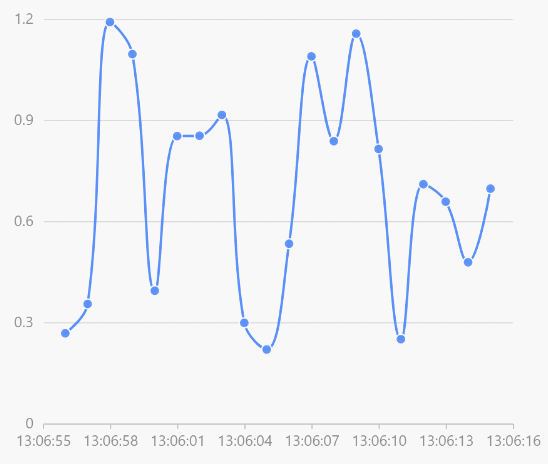效果

示例代码-api介绍
import { Line } from '@antv/g2plot';
function getData() {
// generate an array of random data
const data = [];
const time = new Date().getTime();
for (let i = -19; i <= 0; i += 1) {
data.push({
x: time + i * 1000,
y: Math.random() + 0.2,
});
}
return data;
}
const line = new Line('container', {
data: getData(),
padding: 'auto',
xField: 'x',
yField: 'y',
xAxis: {
type: 'time',
mask: 'HH:MM:ss',
},
smooth: true,
point: {},
});
line.render();
setInterval(() => {
const x = new Date().getTime(), // current time
y = Math.random() + 0.2;
const newData = line.options.data.slice(1).concat({ x, y });
line.changeData(newData);
}, 1000);Vue组件方式
组件
<template>
<div id="Histogram" ref="Histogram" :style="getHeight()"></div>
</template>
<script>
import { Column } from '@antv/g2plot'
let chartChange
export default {
props: {
value: {
type: Array,
default() {
return []
},
},
Height: {
type: Number,
default: 0,
},
},
data() {
return {
radarPlot: null,
}
},
// 监听
watch: {
value: {
handler(newVal, oldVal) {
console.log(newVal)
// 方式一 有新数据从新渲染图表
chartChange.changeData(newVal)
// 方式二 先销毁图表 在创建图表
// chartChange.destroy()
// this.initRadarPlot()
},
deep: true, //深度监听
// immediate: true,
},
},
mounted() {
this.initRadarPlot()
},
methods: {
initRadarPlot() {
// 使用ref的方式组件可以多次使用
// const chartChange = new Column(this.$refs.Histogram, {
chartChange = new Column(this.$refs.Histogram, {
data: this.value,
height: this.Height,
xField: 'label',
yField: 'amount',
label: {
// 可手动配置 label 数据标签位置
position: 'top', // 'top', 'middle', 'bottom'
// 可配置附加的布局方法
layout: [
// 柱形图数据标签位置自动调整
{ type: 'interval-adjust-position' },
// 数据标签防遮挡
{ type: 'interval-hide-overlap' },
// 数据标签文颜色自动调整
{ type: 'adjust-color' },
],
content: (originData) => {
return originData.amount + '%'
},
style: {
fill: '#000',
},
},
tooltip: {
formatter: (originData) => {
return { name: '占比', value: originData.amount + '%' }
},
},
xAxis: {
// title: {
// //title:null 不显示title
// style: {
// fontSize: 14,
// fill: 'red', // 文本颜色
// },
// },
label: {
// style: {
// fill: 'green',
// },
autoHide: true,
autoRotate: false,
},
},
yAxis: {
min: 0,
// max: 20,
// title: {
// //title:null 不显示title
// style: {
// fontSize: 14,
// fill: 'red', // 文本颜色
// },
// },
label: {
// formatter: (originData) => `${originData}%`,
// style: {
// fill: 'green',
// },
autoHide: true,
autoRotate: false,
},
// line: {
// style: {
// stroke: 'red',
// },
// },
},
meta: {
label: {
alias: '销售额趋势',
},
amount: {
alias: '占比',
},
},
// legend: {
// // layout: 'horizontal',
// position: 'right',
// },
})
chartChange.render()
},
// 图表高度
getHeight() {
let height = parseInt(this.Height)
return { height: height + 'px' }
},
},
}
</script>
<style>
</style>不要将chart实例化在初始化方法里,将这个实例保存下来
重载方法不要去new Chart
使用
<template>
<Histogram :value="HistogramData" :Height="350" />
</template>
<script>
import { Histogram } from '@/components'
export default {
name: 'WorkBench',
components: {Histogram},
data() {
return {
HistogramData: [
[
{
label: '2022-06',
amount: 17,
},
{
label: '2022-05',
amount: 12,
},
{
label: '2022-04',
amount: 40,
},
{
label: '2022-03',
amount: 1,
},
{
label: '2022-02',
amount: 10,
},
],
],
}
}
}
</script>